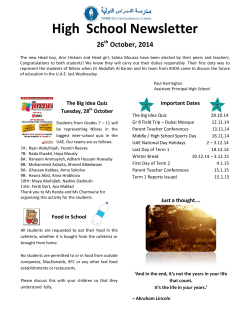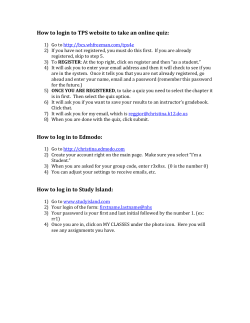
How to Teach a 90 Minute Class Period Presented by
How to Teach a 90 Minute Class Period Presented by Cristina Bennett, David Boatright, and Antoinette Howard July 25, 2011 Objective • We will identify and discuss some fundamental practices for effective instruction during the 90 minute class period. Classroom Management • Seating Chart • Classroom rules • Maintain teacher/student relationship at all times. • Student expectation must be clear. They must maintain YOUR rules. Structure • Variety of Activities – Bell Ringers – Warm up exercises – Tardy Quiz – Note taking – Guided Practice – Independent Practice – Closing Sample 90 minute class period 8:15 – 8:30 Bell ringer/Quiz/TAKS questions (musical cues) 8:30 – 8:40 Assess, go over TAKS questions 8:40 – 8:50 Copy notes (musical cues) 8:50 – 9:05 Go over lesson 9:05 – 9:20 Student led guided practice 9:20 – 9:40 Independent practice (musical cues) 9:40 – 9:45 Closing/Lesson summary The Notebook • Lesson is summarized by you, not by textbook writers. • Include several examples of homework problems. • Allow students to use notebook on quiz or test as a tool. • Prepares for college. Grading Procedure • Homework – make sure it is relevant because it can become busy work • Quizzes are a better indicator of understanding • Reasonable homework assignment • Test what you have taught • Review sheet for Major Tests and Finals • Extra credit on quiz – TAKS questions • Extra credit on Homework – Pre/AP, AP questions 90 minute break down 20-60-10 – 20 minute whole group instruction – 60 instruction or learning station rotation – 10 minute wrap up or summary The Formula for Quality Instruction The Fundamental 5 • The Fundamental Five are the five critical practices that are at the core of highly effective instruction. • These practices are: – Frame the Lesson – Work in the Power Zone – Frequent, small group, purposeful talk about the learning – Recognize and Reinforce – Write Critically Frame the Lesson • Allows you to look at material you want to teach. • Helps you plan better. • Tells the learner what you are going to teach. • Share the closing product or task. • Improves the quality of feedback from observer. Working in the Power Zone • A teacher occupying the power zone is simply teaching or monitoring in close proximity to one student, a small group of students or the entire classroom full of students. • When teachers conduct their practice in the power zone a number of significant changes occur in the classroom dynamic. – On task behaviors increase – Discipline issues decrease – Student retention of content increases – Student achievement increases Power Zone, cont. Make a conscious commitment to the practice. Purposefully arrange the classroom to facilitate teacher movement. Limit or remove common teacher distractions(i.e. turning computer off, keeping desk clean and organized). Proximity instruction=position yourself in the action. • Move about the room checking on everyone. • Reinforce positive behaviors. • Perform frequent and ongoing formative assessment. • Continually micro-adjustments the instruction. Frequent, Small –Group Purposeful Talk about the Learning • After 10-15 minutes of teacher talk, then students talk (groups of 2-3). Seed Question: Practice of using pre-planned questions that guide student conversations toward the desired learning outcome. • Why should we stop & talk purposefully? *It can stretch the rigor & relevance of the lesson. *Allows for differentiated instruction. *Cements the learning for some. *Peer tutoring for those who didn’t get it. More time in Power Zone=better learning, better classroom management, and strategy enhancement. Recognize and Reinforce • Make a big deal of the small things. – A low performing student scores a passing grade on a test. – A student who never turns in homework, turns in an assignment. • Start reinforcing the work it takes to be successful. – Personalization and specificity allows you to shape the behavior. • Look for the positive, good things going on and be specific. • Benefits – Recognition provides students with motivation to continue pursuing academic success. – Reinforcing the work builds habits which allows for improvement in student performance. Writing Critically • Critical writing defined as writing for the purpose of organizing, clarifying, defending, refuting, analyzing, dissecting, connecting, and/or expanding on ideas or concepts. • Most natural and authentic way to increase the rigor. • Give the students time to do it (5-10 mins) • It can consist of a simple list, a short comparison paragraph, a quick summary, a mind map, purposeful note taking (i.e. Cornell notes), a written exit ticket, or a formal essay or term paper. • It is not copying neither is it a fill in the blank activity or free writing. Write more=remember more=reading improves=better understanding=own the learning A Vision for K-12 Students Today • http://youtu.be/_A-ZVCjfWf8 Team/Department Expectation for Lesson Planning Lesson Plan Framework • Depts. must submit a team lesson plan to include all team member’s names. • SPED CWC teachers are expected to collaborate with their co-teacher and submit a lesson plan indicating modifications made to the lesson for their monitoring students. • Lesson plans must be submitted via email to your supervisor and ICC/ Dept. chair. • Lesson plans must be submitted every two weeks beginning August 1st by 8:00 a.m. Lesson Plan Due Dates (By 8:00 a.m.) August 1, 15 & 29 September 12 & 26 October 17 & 31 November 14 December 5 January 5, 17 & 30 February 13, & 27 March 12 & 26 April 16 & 30 May 14 Lesson Plan Format Each dept. must have the following information on their lesson plan. TEKS Objective Student Expectation Activities 1. Bell Ringer 2. Activity 3. Activity 4. Activity Assessment Formative Summative Key Vocabulary Resources **Differentiated instruction must show throughout the lesson plan Team Planning • Core departments/teams will meet the first 45 minutes of the designated team plan period on each day it occurs. • Refer to team planning schedule for designated periods and exact dates. • Teams will notify ICC/Dept. chair of the location of the meeting to be added to planning schedule. The game has changed; we must change the way we plan to win. Reference Cain, S. and M. Laird. 2011.The Fundamental 5: The Formula for Quality Instruction. Nesbitt, B. A Vision for K-12 Students Today.
© Copyright 2025





















